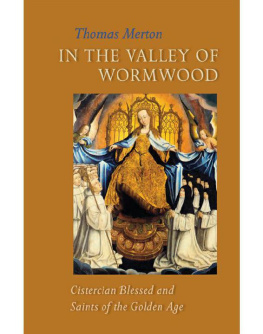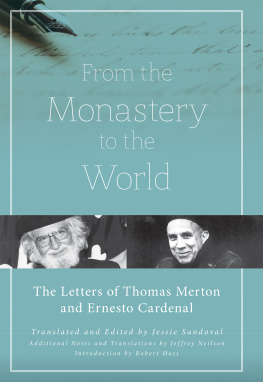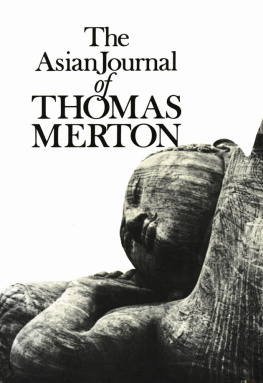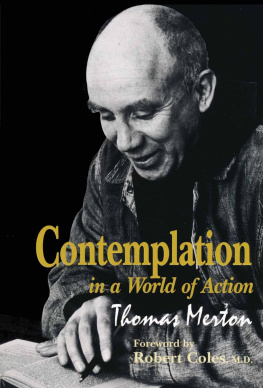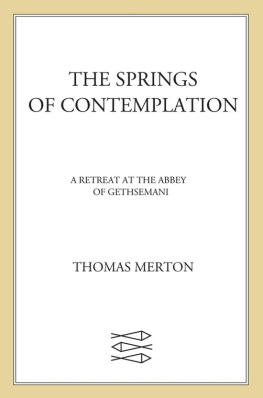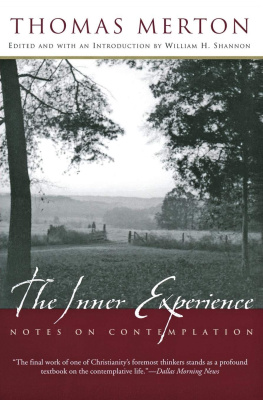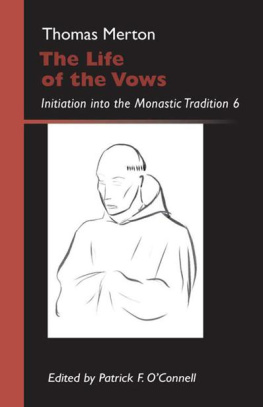CISTERCIAN STUDIES SERIES: NUMBER TWO HUNDRED THIRTY-THREE
Thomas Merton, OCSO
In the Valley of Wormwood
Cistercian Blessed and Saints of the Golden Age
CISTERCIAN STUDIES SERIES: NUMBER TWO HUNDRED THIRTY-THREE
Thomas Merton, OCSO
In the Valley of Wormwood
Cistercian Blessed and Saints of the Golden Age
Edited with an Introduction by
Patrick Hart , OCSO
Foreword by
Brian Patrick McGuire

LITURGICAL PRESS
Collegeville, Minnesota
www.litpress.org
A Cistercian Publications title published by Liturgical Press
Cistercian Publications
Editorial Offices
Abbey of Gethsemani
3642 Monks Road
Trappist, Kentucky 40051
www.cistercianpublications.org
2013 by Order of Saint Benedict, Collegeville, Minnesota. All rights reserved. No part of this book may be reproduced in any form, by print, microfilm, microfiche, mechanical recording, photocopying, translation, or by any other means, known or yet unknown, for any purpose except brief quotations in reviews, without the previous written permission of Liturgical Press, Saint Johns Abbey, PO Box 7500, Collegeville, Minnesota 563217500. Printed in the United States of America.
The Library of Congress has cataloged the printed edition as follows:
Library of Congress Cataloging-in-Publication Data
Merton, Thomas, 19151968
In the Valley of Wormwood : Cistercian blessed and saints of the golden age / by Thomas Merton, OCSO ; edited with an introduction by Patrick Hart, OCSO. pages cm. (Cistercian studies series ; no. 233) ISBN 9780879071332 ISBN 9780879077587 (ebook) 1. CisterciansBiography. 2. TrappistsBiography. 3. Christian saintsBiography. 4. BlessedBiography. I. Hart, Patrick. II. Title. BX3455.M47 2013 271.12022dc23 [B]
2013015121
Contents
Brian Patrick McGuire Patrick Hart, OCSO
Foreword
For anyone interested in Thomas Mertons inner life as monk of Gethsemani in the 1940s, this collection of biographies of Cistercian holy men and women is a welcome publication. In 1986, when I first visited Gethsemani, I noticed a number of typescript collections of Mertons unpublished works. I wondered what their fate would be, and it is good to know that most of them by now have become available to the world outside of Gethsemani
In the Valley of Wormwood , however, provides more than insight into Merton. These brief biographies, in the tradition of hagiography or saints lives, are a welcome alternative to the oft-told institutional history of the Cistercians. Merton wanted to get to know the people who had created what he called the golden age of Cistercian life, and so he dug carefully through the difficult and confusing tomes of the Patrologia Latina and the Acta Sanctorum , together with the supplementary information that he could find within the Order itself. His bibliography shows that he read everything he could get his hands on, and certainly the quiet atmosphere of an old-fashioned Trappist monastery must have been conducive to such intellectual labor. Provided, of course, that the abbot was interested in allotting time to such a pursuit. Merton was fortunate to have such an abbot, Frederic Dunne.
What do I, as a medieval historian, discover when I read through these lives? I find Mertons attention to describing and defining the Cistercian way of life not something that one would expect from a Trappist in the preVatican II world of the 1940s. Merton was attracted to asceticism of Gethsemani, but he wanted to add his own appreciation of literature and to make his own literature. In finding his way into the early Cistercian sources, he contributed to the return to the sources that came to characterize the Trappist-Cistercian renewal of the 1960s and 1970s. As in so much else in his all-too-brief life, Merton was prescient: he saw that his monastery and its Order needed to know more about the people who had preceded the seventeenth-century La Trappe. Merton wanted to return to the great beginning, the Exordium , of the Cistercians before they became Trappists.
It was not easy. In his own preface to this collection, Merton claims that the Exordium Magnum of the Order deals only with the monks of two of our old monasteries. The Exordiums stories, collected around 1200 by Conrad of Eberbach, in fact, deal with many Cistercian monasteries, but Merton was handicapped by the incomplete text he found in the Patrologia Latina. He would have had to wait for the 1962 critical edition by Bruno Griesser, but by then he had other concerns. It is only recently that Cistercian Publications has issued a superb English translation of The Great Beginning of Cteaux , which makes available to a broader public what Merton could find only in Latin.
The fact that this collection of Mertons biographies of the Cistercian blessed and saints contains small faults and imperfections does not diminish its validity as a witness to Mertons perception of Cistercian life and spirituality in its beginnings and early development. Merton shares with his sources a Cistercian love of story: for example, his telling of blessed Amadeus the Elder who used to clean the monastery sewer even in summer when in the heat of noonday he armed himself with a shovel and attacked this grim task under the burning sun and clouds of fliesone can imagine the stench; and of Saint Guerin leaving the monastery of Aulps behind, but then hearing its bells begin to ring of their own accord. Merton is skeptical, for Saint Guerin was several miles from the monastery, but the modern author believe in miracles, just as his saints did.
Mertons sketches will initiate discussion on the question of what Cistercian sainthood involves. He conceded that the Order had not been particularly interested in its holy people, and today one might ask if Merton himself, who is probably the best-known Cistercian of the twentieth century, was a saint. Or the brothers of Atlas in Algeria: Can they be called martyrs? Would they have wanted such a title?
Fortunately, one can read these sketches without answering such questions. Merton opened the door for a new understanding of Cistercian life and spirituality. We can follow him into an attractive but difficult world, a world where few persevere but that inspires many of us watching from the outside and moves us to prayer.
Brian Patrick McGuire
Kalundborg, Denmark
First Sunday of Advent, 2012
Introduction
These monastic sketches of the Cistercian Blessed and Saints were written by a relatively unknown Trappist monk, Frater Louis, in the mid-1940s at the Abbey of Gethsemani, situated in the knob country of Kentucky. Although first published anonymously, they can now safely be attributed to a youthful Thomas Merton.
Shortly after Mertons entrance into the monastery in December 1941, Abbot Frederic Dunne, the first American monk to persevere at the Abbey of Gethsemani, encouraged Frater Louis to make the Cistercians better known in the new world. With his considerable literary gifts, Frater M. Louis Merton set out to do so by writing his own Cistercian Menology of the blessed and the saints of the twelfth and early thirteenth centuries. The text reflects the enthusiasm and fervor of early Cteaux, then a new charism of the church which would quickly spread throughout the world, east and west, north and south.
It should be remembered that Abbot Frederic Dunne came from a family of book printers and binders in Ohio and was predisposed to appreciate the linguistic abilities and literary gifts that Frater Louis brought with him from his studies at Cambridge in England and Columbia in New York. Once Mertons masters thesis, titled Nature and Art in William Blake , was completed, he embarked on the research for his doctoral dissertation about the poetry of Gerard Manley Hopkins. His notebooks are still a part of the Merton Collection at Saint Bonaventures University, Olean, New York, where Merton taught English literature before entering the Abbey of Gethsemani on December 10, 1941, beginning his novitiate a few days later on the Feast of Saint Lucy.
Next page
